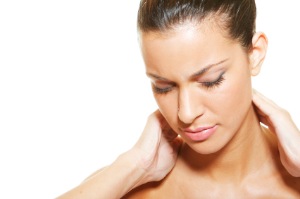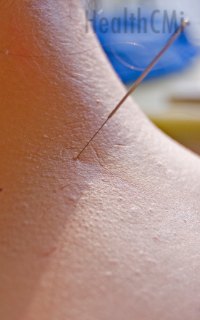Researchers conclude that acupuncture combined with massage is effective for the treatment of cervical vertigo. This condition is a type of dizziness often caused by abnormalities in neck proprioceptors or by vascular compression. Patients experience a feeling of spinning. Cervical vertigo may be caused by head or neck trauma, neck arthritis, surgery to the neck, Meniere’s disease, inner ear disorders and other issues.  Common treatments include physical therapy, medications including muscle relaxants, cervical blocks and surgery. In this new acupuncture continuing education study, the combination of acupuncture and massage is shown to produce significant positive patient outcomes with a total effective rate of 95%.
Common treatments include physical therapy, medications including muscle relaxants, cervical blocks and surgery. In this new acupuncture continuing education study, the combination of acupuncture and massage is shown to produce significant positive patient outcomes with a total effective rate of 95%.
Cervical vertigo differs from other types of vertigo in that this diagnosis refers to cases wherein proprioception of the neck is disturbed. Proprioception is the ability to sense the body’s position, motion and equilibrium. For example, a blindfolded individual can sense if their leg is lifted or their hand is raised above their head. Disturbances in proprioception of the neck may lead to dizziness, cervical vertigo. Intensity may range from mild to severe. Associated symptoms include loss of balance, lightheadedness, blurry vision, nausea and vomiting.
Researchers from the Rehabilitation Department of No. 2 People’s Hospital of Linhai City (Zhenjiang) randomly divided 84 patients with cervical vertigo into two groups. Group #1 received standalone Chinese medicine massage treatments. Group #2 received a combination of acupuncture and massage treatments. After two weeks, patients in group #2 achieved an overall effective rate of 95% compared with 79.95% for group #1. Based on the clinical outcomes, the researchers conclude acupuncture combined with massage is a highly effective approach for the treatment of cervical vertigo.
Traditional Chinese Medicine (TCM) categorizes cervical vertigo as a disease of dizziness. TCM differential diagnostics identify several underlying syndromes giving rise to cervical vertigo including qi and blood stagnation, liver and kidney yin deficiency, qi and blood deficiency and vascular issues causing insufficient blood supply to the brain. The combination of acupuncture and massage is identified by the researchers as having several beneficial effects: improved blood oxygen supply, enhanced microcirculation of blood to the affected region, reduced muscle spasms and pain. Transcranial Doppler (TCD) measurements confirm that the combination of acupuncture and massage increase blood flow in the vertebrobasilar arteries and brain. In addition, TCD measurements confirm that needling the acupoint Jingming (UB1) significantly improves cervical vertigo patients’ speed of blood flow in the vertebrobasilar arteries.
Massage
The massage treatments were administered with patients in a supine position. The therapist, seated near the patients’ heads, applied massage therapy to relax local muscles of the neck, shoulders and upper back. Points of tenderness received special attention along with acupressure to acupuncture points Fengchi (GB20), Jianjing (GB21), Baihui (DU20) and related points for 1 - 2 minutes per each acupoint. In some cases, the therapist applied upward static force pull-outs for 15 seconds per pull. The duration of each massage was 30 minutes. The massage treatment was applied every other day with one week comprising one course. The entire treatment lasted for two courses. 
Acupuncture
The patient took a prone posture with head slightly leaning forward and neck muscles relaxed. One cun filiform needles were used. Acupuncture needling was applied to Fengfu (DU16), Baihui (DU20) and Xuanzhong (GB39) bilaterally with even reinforcing and reducing manipulation methods. The depth of insertion was 15 to 25 mm and the retention of needling was 30 minutes per acupuncture session. The treatment was applied once daily for a course of two weeks.
Results
After two weeks, both groups demonstrated positive clinical outcomes. The massage group had 17 patients cured, 8 patients having made remarkable improvements, 5 patients having made moderate improvements and 8 patients having made no improvements. The combination group had 80 patients cured, 5 patients having made remarkable improvements, 8 patients having made moderate improvements and 2 patients having made no improvements. Based on the above outcomes, the researchers conclude that the combination of acupuncture and massage is safe and effective for the treatment of cervical vertigo.
Reference:
Jin, Jian, Lingdan Zhao. “The effect of massage and acupuncture on elderly patients with cervical vertigo.” Chinese Journal of Gerontology 34.9 (2014): 2403-2405.


